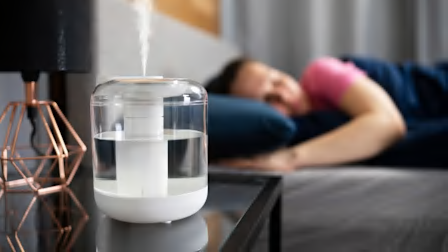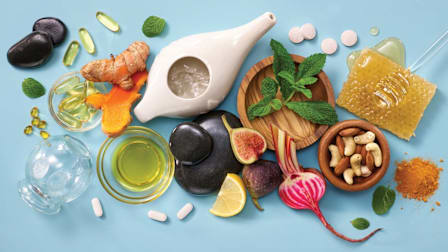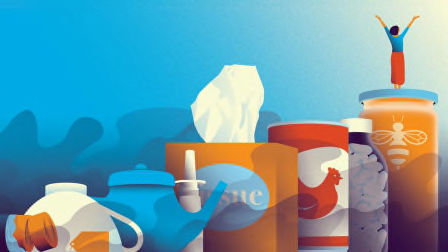How to Stay Healthy This Winter, Wherever You Go
Traveling by plane? Dining out? Going to a wedding? These tips can help you avoid COVID-19, colds, and more.

The seasonal surge of respiratory viruses are here—and no one wants to miss out on any fun because they’re sick.
Vaccines and antiviral drugs have made COVID-19 (and the flu) more manageable, but you still can get seriously ill from any respiratory virus, says Trish Perl, MD, an infectious disease specialist at the University of Texas Southwestern Medical Center in Dallas. Boosting your immune system and taking steps to avoid germy places and people can help. These tips for overall health and advice for common situations can help you stay healthy when you’re out and about.
4 Steps for Overall Health
Stay up to date on vaccines. This is your strongest defense against getting severely sick from a respiratory bug, says William Schaffner, MD, an infectious disease specialist at Vanderbilt University Medical Center in Nashville, Tenn. Discuss with your doctor, but here’s what is recommended: a high-dose flu shot (Fluad, Flublok, or Fluzone High-Dose), the updated COVID-19 shot, the respiratory syncytial virus (RSV) shot, and the pneumococcal (PCV) vaccine.
Dining in Restaurants
Choose your place. Pick an eatery where tables are about 6 feet apart, and choose one on the periphery. "Sitting against a wall is good, because the only exposure you’ll have is right in front of you, and on the sides," says Bawer.
Mask or not? If it’s just a few of you dining at a place that’s not very crowded, you probably don’t need a mask, says Albert Shaw, MD, an infectious disease specialist at the Yale School of Medicine in New Haven, Conn. In crowded restaurants, consider it.
Wipe away. You may want to disinfect the table with a hand wipe that’s at least 60 percent alcohol. "Most places will wipe the table down beforehand, but they could use the same rags they used to clean other tables," Bawer says.
Going Shopping
Time it right. Shop online or at off-hours, like early morning, on weekdays. Stand-alone stores may put you in contact with fewer people than shopping malls. If you have an important event coming up, you may want to have groceries delivered.
Clean your cart. Go over shopping carts and baskets (especially the handles) with an alcohol-based hand wipe. This won’t just protect you against respiratory bugs—research suggests more than 70 percent of grocery carts have fecal bacteria on them, which can cause gastrointestinal symptoms like diarrhea.
Choose self-checkout. This reduces close contact with others, especially if you use a credit card or payment system such as Apple Pay or Google Pay.
For Big Events
Pick and choose. While a niece’s wedding may be a yes, you may want to skip, say, big indoor sporting events, where people are screaming. "They’re projecting viruses all over the place and don’t know it," Schaffner says.
Ask about group testing. For that large wedding, consider asking the host to encourage everyone to do an at-home COVID-19 test beforehand.
Mask . . . sometimes. If viruses such as COVID-19 and flu are on the rise in your area, it’s a good idea to wear a mask unless you’re eating or drinking, says Schaffner. Carry extras, so if someone next to you is coughing or sneezing, you can politely offer them a mask (or a tissue, if that’s all you have). Then move as far away from them as you can.
Sip alcohol in moderation. Too much suppresses the immune system, says Kenneth Koncilja, MD, a Cleveland Clinic geriatrician who advises limiting yourself to a drink or two.
On an Airplane
Put on that mask. It will help protect you against any respiratory virus circulating. An N95 or a KN95 is considered best, but if you find those really uncomfortable, "The most important thing is a mask that covers your face, and also provides a good seal around your nose and mouth," says Perl. It’s especially important if someone nearby is coughing or sneezing, because it’s hard to switch seats on crowded planes.
Disinfect your area. Some viruses, like RSV, tend to stick to surfaces, says Perl. So rub down your armrest, seat belt, and food tray with hand wipes, then wash your hands or clean them with hand sanitizer afterward. "Otherwise, if you touch a contaminated surface and then touch your eye or put your finger in your mouth, you’ll have undone all your hard work," Perl says.
Open your air vents. While the plane is in the air, cabin air is refreshed 20 to 30 times an hour, which helps remove germs. But some viral particles can still linger, especially if you’re near someone coughing or sneezing. Keeping air vents open can help.
Stay hydrated. The low humidity in airplane cabins can dry out the mucous membranes in your nose, which may make you more susceptible to viruses. The Aerospace Medical Association recommends about 8 ounces of water per hour while on your flight. You may also want to spritz your nose with a nasal saline spray, to help keep those membranes moist.
If You Get Sick Anyway
Starting to cough, sneeze, or feel all-over lousy? When symptoms arise, your first step should be a home COVID-19 test, Schaffner says. If it’s positive, call your doctor and ask whether you’re a candidate for the antiviral drug Paxlovid.
If it’s not COVID-19, have your doctor test you for the flu. Positive for flu? Ask whether you should use an antiviral drug like Tamiflu.
And for any respiratory bug, hunker down at home as much as possible. This protects you and others: If you have a respiratory virus, your immune system is already on overdrive, Bawer says. It’ll be less able to fight off any more potentially serious bug you might encounter.
Also, drink plenty of fluids, use a saline nasal rinse, and run a cool-mist humidifier. Ask your doctor which over-the-counter meds are best and safest for you. These may include acetaminophen (Tylenol and generic) for fever and body aches, and expectorants like guaifenesin (Mucinex and generic), which make it easier for you to cough up mucus. Go back to normal activities when, for at least 24 hours, your symptoms are improving and you’re fever-free without meds.
Editor’s Note: A version of this article also appeared in the December 2024 issue of Consumer Reports On Health.




















